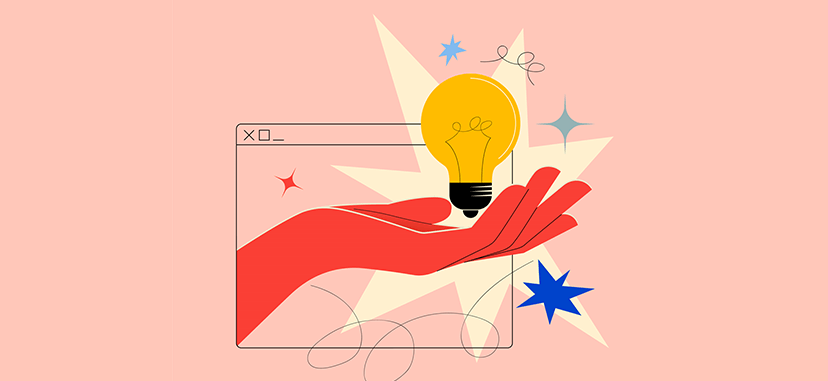
Click the button to start reading
11 Ideation Techniques that Go Beyond Brainstorming
Does your team keep running into the same challenges over and over again? Maybe it’s a struggle to come up with fresh ideas or think outside the box on your current project. That’s where ideation techniques come in.
Ideation is the third step in the design-thinking process, where the main focus is to generate new ideas – start with quantity and originality, then go for quality! The technique helps teams overcome rigid thoughts and patterns and delve into out-of-the-box or otherwise unexpected ideas. An ideation session can spur creativity, energize tired teams, and get you out of a rut on repetitive challenges – it’s safe to say just about any team can benefit.
Want to try out some new ideation session techniques with your team? Read on to learn more about the design thinking process, what the ideation stage is, plus what we think are the 11 best ideation techniques that can take your team far beyond brainstorming.

A Quick Intro to Design Thinking
Design thinking is a process that can be used to help teams solve problems and develop creative solutions. Before we get into ideation, let’s walk through the five phases of design thinking.
- Empathise. The empathy phase is about getting into the needs and frustrations of your clients. You can manage this phase with surveys, interviews, Google trends, or focus groups. This phase stresses that by understanding your clients on a deeper level, you’ll be better able to develop creative solutions that meet their needs.
- Define. The define phase pushes teams to collate information gathered in the empathy phase and create a solid definition of the problem. To define the problem, you’ll want to outline all the variables (user needs, business requirements, constraints, assumptions, etc.). By being as specific as possible, you’ll be better able to create solutions that address the problem.
- Ideate. The ideation phase is what we’re exploring in more depth below! At a glance, this phase is about generating new ideas. By fostering innovation and creating new approaches, project managers will have more options for addressing the problem outlined in the define phase.
- Prototype. The prototyping phase is about bringing the best ideas into reality as a mockup or blueprint. Creating a prototype allows you to collect feedback and improve or add features based on the client’s needs.
- Test. In the testing phase, you try out your prototype in the real world. This phase is about fine-tuning and making necessary adjustments until your product or service addresses the problem as closely and effectively as possible.
Want to learn more about the design thinking process? Here’s a comprehensive look at the process and how design thinking can improve your future projects.

What is ideation and why is it important?
As outlined above, ideation is the third phase of the design thinking process. Ideation is “the process of generating a broad set of ideas on a given topic, with no attempt to judge or evaluate them,” according to the Nielsen Norman Group.
The intention in the ideation phase is about the quantity of ideas over quality! It’s about creating as many possible solutions that address your customer’s needs, no matter how unconventional or unlikely. Successful ideation should push constraints and challenge assumptions – it’s better to come up with bold ideas that aren’t possible than things that have been repeated many times before! Remember – you still have the prototype and testing phase to be practical. So aim to make your ideation sessions as no-judgment, out-of-the-box, and collaborative as possible.
Easy enough, right? But what allows for this kind of thinking? There are some simple things you can do to set your team up for a more beneficial ideation session. For example, you can host your creative ideation session in a new environment outside the office, use ice breakers, or take other measures to make our employees feel more relaxed.
And once you’ve done that? Your results will depend on which ideation technique you choose.

Ideation Techniques
So, what are ideation techniques? You can think of design thinking ideation techniques as the structure or guidance for an ideation session. You can try these creative prompts, methods, or collaboration styles within your team to see what ideas come up.
There are many different types of ideation techniques, but brainstorming is best known.
What is brainstorming?
Brainstorming. We’ve all heard the word before. But what is the brainstorming technique, actually? It’s a group ideation technique that gets a group to blend their ideas to discover a good idea. The point of brainstorming is that it’s collaborative and interactive. It’s about team members building upon each other’s ideas and developing something better than they could have on their own!
The intention is that it’s no-judgment, unrestricted and that the session values quantity of ideas over quality. An effective brainstorming group should often be limited to 5-7 people and 20-minute sessions.
While it’s one of the best ideation techniques, brainstorming also has limitations. Some of the common drawbacks to brainstorming are…
- Social pressure. We are still humans! Even with the best intentions to bravely create ideas and think outside of the box, we have an instinctual desire to conform to the ideas of others and fear rejection. Since brainstorming relies on boldness, this technique might only suit some personalities.
- Dominant personalities. As an extension of that, brainstorming is set up for more dominant personalities. The people who talk the loudest or speak most confidently are the most likely to have their ideas recognized. This can also result in a lack of diversity or inclusion in the final outcome.
- Time constraints. Since there are limits to how long a brainstorming session lasts and group energy can wane, brainstorming sometimes generates impractical or poorly considered ideas. In some ways, that’s the point! But you might benefit more from a more constrained or practical ideation technique, depending on the nature of your challenge.
- Lack of followthrough. Since brainstorming sessions lead to a large volume of ideas, there must be an editing process where the best ideas are passed into the prototyping phase. Without this step, you will leave a lot of good ideas on the table, unfinished and unexecuted.
- Limited creativity. Brainstorming leverages just the ability to think and verbally express ideas. You might have team members who are more visual, introverted, or who are more creative with deep thought. Other ideation techniques can help bring out the strengths of all team members.

11 Group Ideation Techniques that Go Beyond Brainstorming
Since this whole ideation phase is about pushing limits, we’ve got many different ideation techniques you can try to push the limits of your team. Of course, there are dozens you can try, but below are eleven creative ideation technique examples that can help your team develop their next big idea.
Since this whole ideation phase is about pushing limits, we’ve got many different ideation techniques you can try to push the limits of your team. Of course, there are dozens you can try, but below are eleven creative ideation technique examples that can help your team develop their next big idea.
- Brainwriting. Brainwriting is an alternative to brainstorming. As the name suggests, participants in a brainwriting session begin by writing out their ideas on a piece of paper (appx. 5 minutes). They’ll pass the paper to the next team member when they’re done. The team member will then read the ideas, take some time to reflect, and elaborate and expand upon the ideas (5 minutes). They’ll then pass it on to the next person in the circle. This process continues until everyone on the team has had a chance to iterate on all ideas. At the end, the moderator can collect the papers, display them, and each idea becomes open for discussion. The significant benefit of brainwriting is that it allows less dominant participants to have their ideas recognized and heard and includes team members who might excel at written expression over verbal.
- Analogies. Analogies as an ideation technique is the process of comparing ideas to spark new ones. You might ask, “If {x} is like {y}, how can we explain different situations through that lens?” The analogies process starts by picking an analogy that somehow relates to the task at hand – let’s say it’s a team of line cooks preparing dinner service. Then, the team is challenged with comparing the situation or current challenge through this lens. Which team is chopping or washing dishes? How do you deal with a vegetable delivery that didn’t arrive? How do you keep some dishes warm while the others are being prepped? The aim of this technique is that by taking something more familiar or easily seen, a team begins to look at the problem in a new light and consider possible solutions. An analogy can also be a helpful tool for memory, ensuring the team stays working towards a common goal.
- Worst Possible Idea. The Worst Possible Idea is also a type of brainstorming technique. But rather than trying to come up with the best solutions to your problem, your team considers – you guessed it – the worst possible ideas. It’s a lateral thinking method that aims to help teams break out of rigid thought patterns and feel more creative or playful. While the ideas generated in this technique won’t be directly practical, they can be surprisingly effective when you flip them around. Finish the session by asking what makes them a bad idea. In doing this, you can identify the problems and convert them into possible solutions. Even if you don’t get your idea from a worst possible idea session, you might find this as a helpful icebreaker before brainstorming or another ideation technique to help your team get into a flow.
- Mind Mapping. Mind mapping is a graphical ideation technique in which participants create a diagram like a web of ideas. An individual might start by writing the problem statement or critical idea in the middle of a page. From there, they can begin writing out their ideas and potential solutions around the problem and drawing lines that connect them. To expand further on this technique, add a layer that explains exactly how your team might accomplish these solutions. What resources, tools, or assumptions would need to be true? The key benefit of mind mapping is that it makes big ideas into smaller and more manageable parts. Since it’s a visual tool, it can also help create logical paths between tasks and stimulate thinking and contribution from more visual members of the team.
- Challenge Assumptions. Challenging assumptions is a method that assumes we are stuck in a way of thinking. We take some things as givens that might not actually be true when we challenge them. For example – phone developers might have assumed that all phones needed buttons before touch screens were invented! It’s by asking questions about assumptions you have for the project that your team can start to rethink processes, outcomes and develop creative solutions. To try the challenging assumptions method, begin with a prompt about what you want to solve or create. From there, you can start listing out assumptions – aim for 20-30 when starting. With all your assumptions listed, you can ask, “How could this not be true?” or “What if…”. With your assumptions challenged, consider what it would take to make these impossibilities into realities. While some things are assumed because they are true, you’re likely to find assumptions you can change with dedication. The Challenge Assumptions method is beneficial for coming up with creative ideas in projects that are stuck or require fresh thinking.
- Sketch or sketch storm. A sketch or a sketch storm is also a good brainstorming alternative for more creative or design-oriented teams. The team will communicate ideas through diagrams or rough sketches instead of words. Sketch storming works best with small teams – 2-7 people – and revolves around a good prompt. Make sure the question or challenge is clear from the onset, and give each person time to think about and conceptualize their idea. This must be done individually and without words or annotations! Those will come later. When the sketches are completed, they can be hung up, and the team might attempt to explain what they see without asking the artist. The benefits of this method are that it provokes new ideas and caters to people who can better express or understand visually. A similar exercise lets participants start a drawing and pass it around for the next person to expand upon before the final review.
- Storyboards. Storyboards aren’t just for movie producers. In design thinking, storyboards are meant to develop a visual representation of a user’s journey with the product or service. Visually, a storyboard might look like a comic book where each step is a square filled in with text or images. Start by thinking about where a user begins and what they want to achieve, and consider the user journey in 4-6 steps. From there, you can explore different timelines, dynamics, and scenarios a user might experience before choosing your panels for the storyboard. By condensing the user journey down to a few steps, you can ensure your team focuses on the most important things first. Storyboarding helps identify missing steps along the way and helps teams align on the user journey while saving on the cost and energy involved in prototyping. And since these sketches are super simple, there are more important things to storyboard effectively than artistic ability.
- Bodystorming. Bodystorming brings yet another type of intelligence to the conversation. With bodystorming, participants will physically act out processes and ideas. Bodystorming is meant to be an empathy-building exercise. So here’s how it works! Start by creating a physical experience that includes props, people, or a simple prototype. When participants have a chance to interact with or experience the scenario physically – hold the product in their hands, for example – they’ll have a better understanding of how they interact with it, what they need, and how they feel than if they’d only sat around a table talking about it. The outcome of a bodystorming session is visual information about why something works (or doesn’t) and helps participants adapt to a more successful model. Additionally, since it gets the group into their body, it’s one of the most energetic, meaningful, and memorable ideation techniques.
- SCAMPER. SCAMPER is a lateral ideation technique that uses seven lenses to provoke out-of-the-box thinking or new ideas. The acronym stands for Substitute (what features can be substituted for something else?), Combine (how can we combine this with something else to make it better?), Adapt (how can we adapt something we already have for a new target group?), Modify (what part of this can we modify to make it better?), Put to another use (what’s another use we haven’t thought about?), Eliminate (what can we eliminate to streamline?) Reverse (what happens if we reversed or reorganized things?). SCAMPER is best applied to an existing product, service, or idea. Consider things like values, features, pricing, etc. as you ask these questions. And, of course, review your work at the end to identify the most viable solutions.
- Gamestorming. Gamestorming refers to any ideation techniques or problem-solving methods that use games to increase engagement, energy, and collaboration during group sessions. Who doesn’t love a game? Almost any ideation technique can be gamified by creating incentives, progress trackers, or adding an element of competition. Gamestorming can be a helpful method for helping participants suspend their everyday beliefs and expectations for a period in the interest of coming up with the best possible solution.
- Round Robin. Round Robin is a brainstorming technique that is broken out into two steps. Step one leverages the HMW inquiry – asking “How might we…?” – to define the problem you’re setting out to solve. With the problem defined, the next step is to have each participant sketch their solutions. After 5-8 minutes, everyone moves to the next block, identifies the risks and roadblocks with the idea in front of them, and sketches these out. The team rotates again, and the next person aims to identify how to mitigate the risks identified by the previous participant. They will then expand on the idea to make it stronger. Ultimately, the group votes on what they think is the best idea. Some templates make this method easy! The most significant benefit of Round Robin is that it expands initial ideas and pushes the team to identify potential risks and their solutions before getting too deep into the process.
Next time your team is facing a seemingly impossible challenge, choosing an ideation technique can help you move out of your rut and into places you never even imagined. Which one will you try?
















